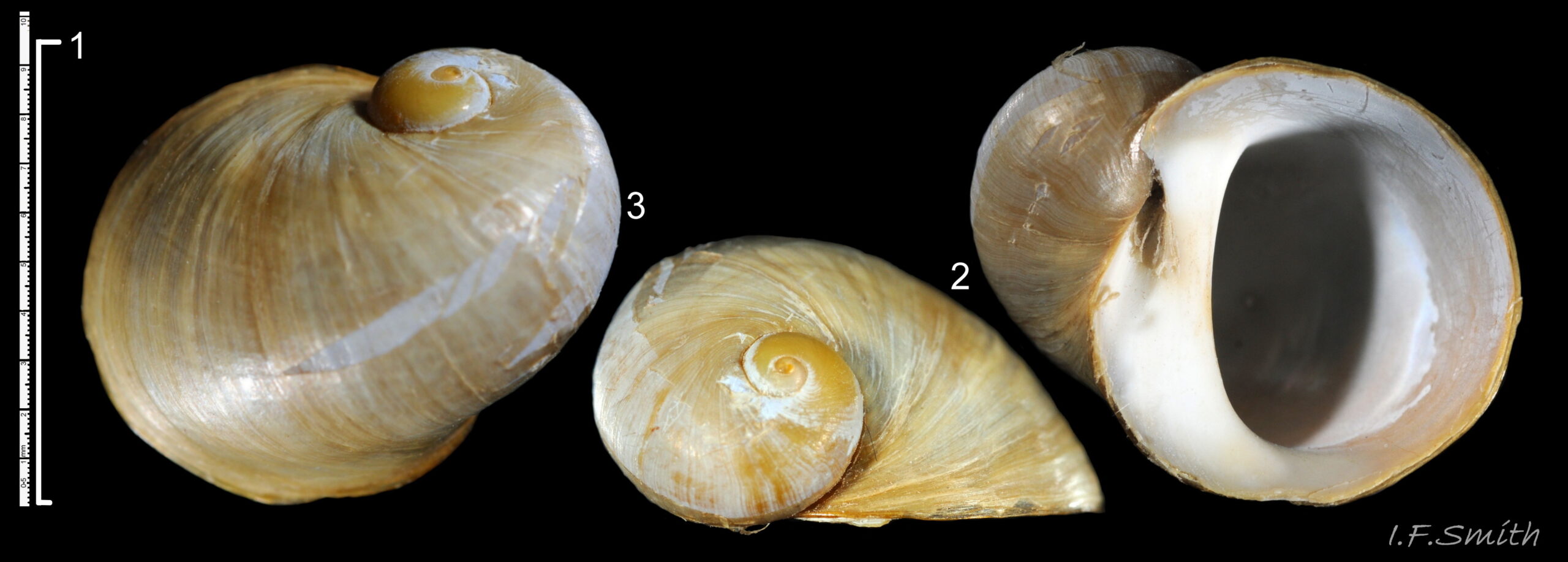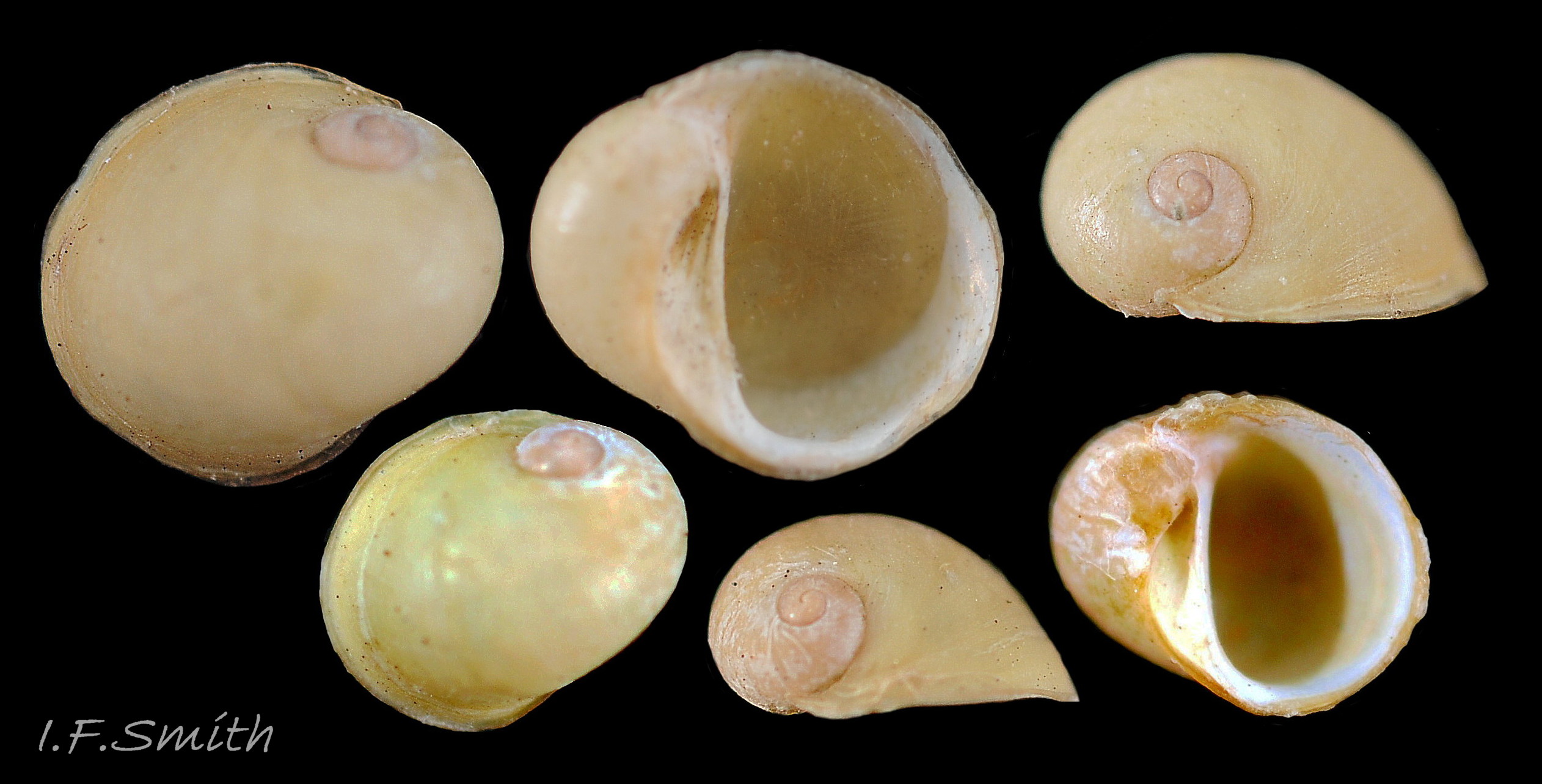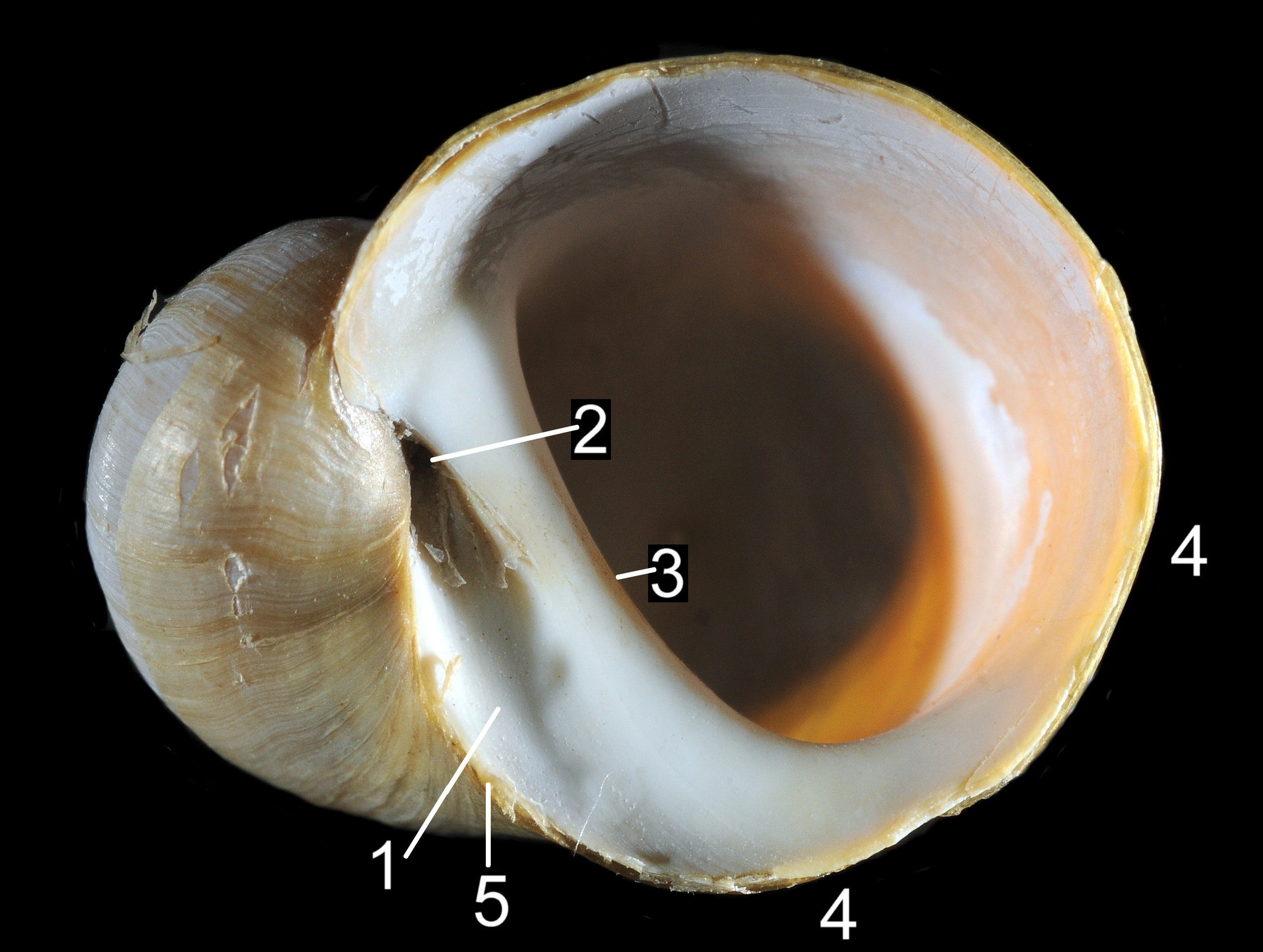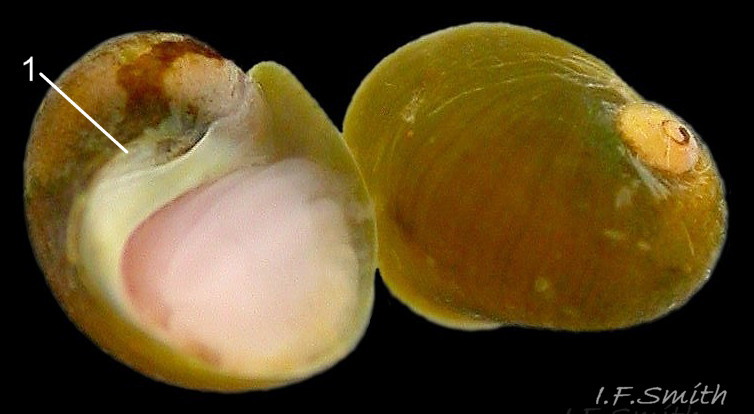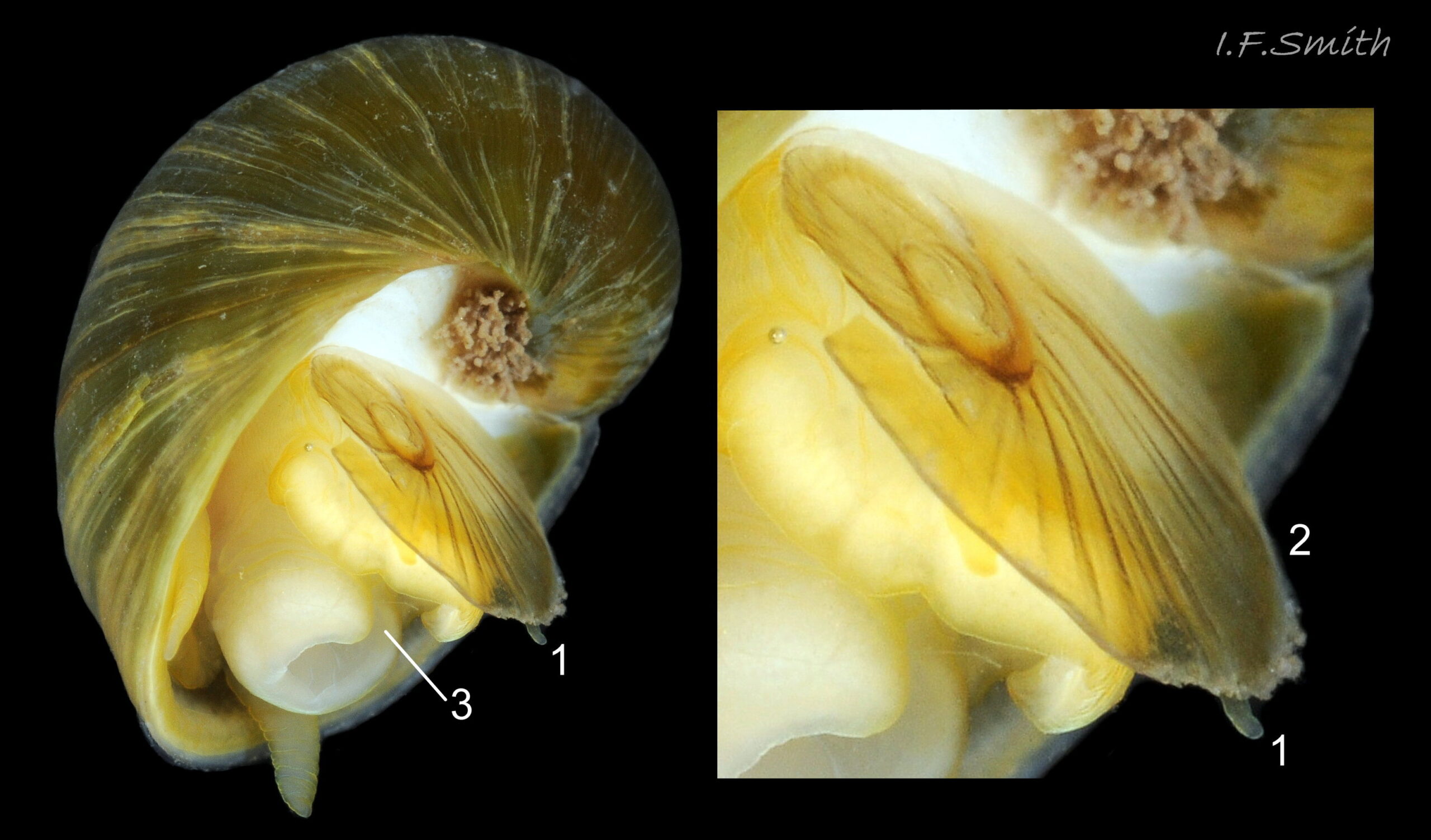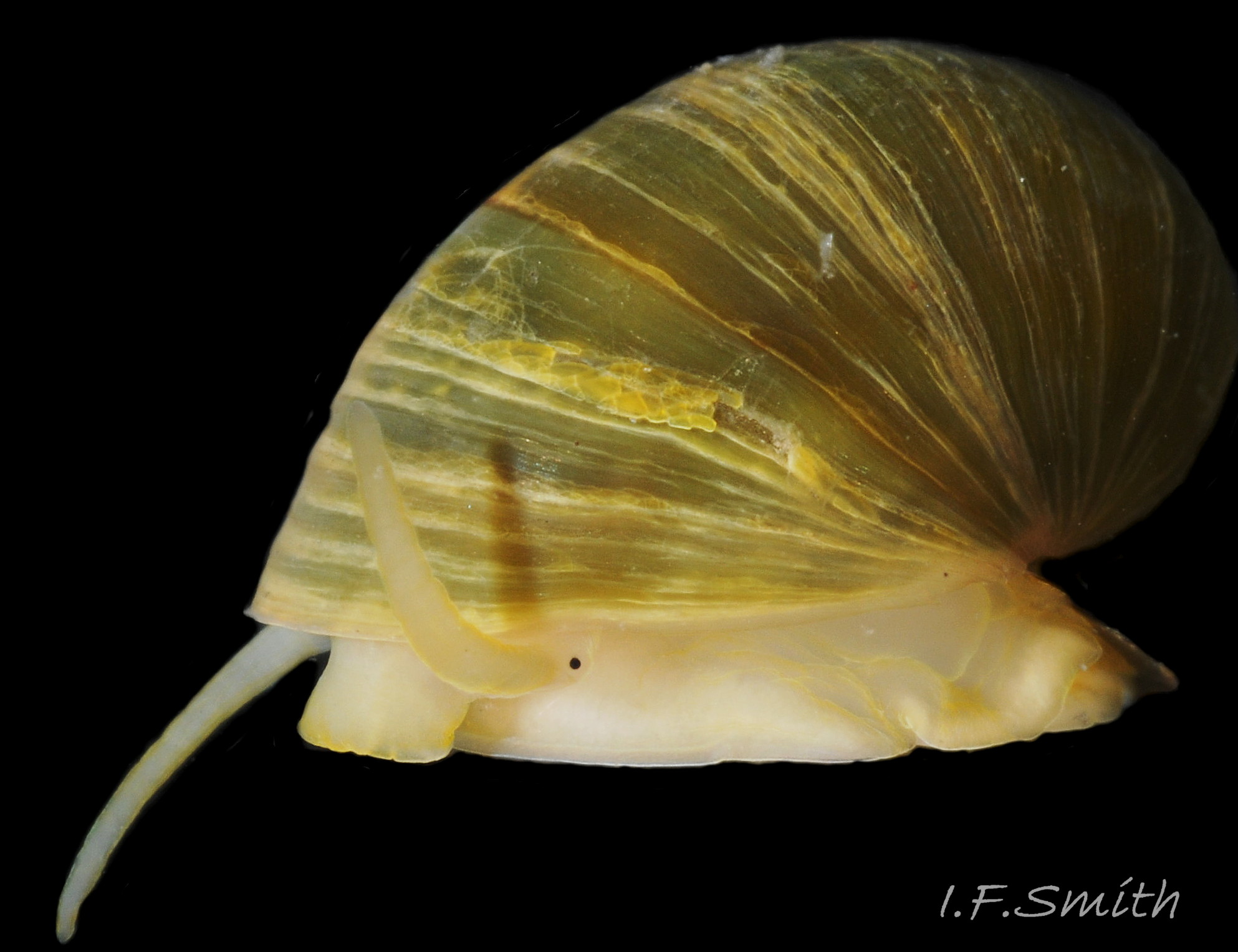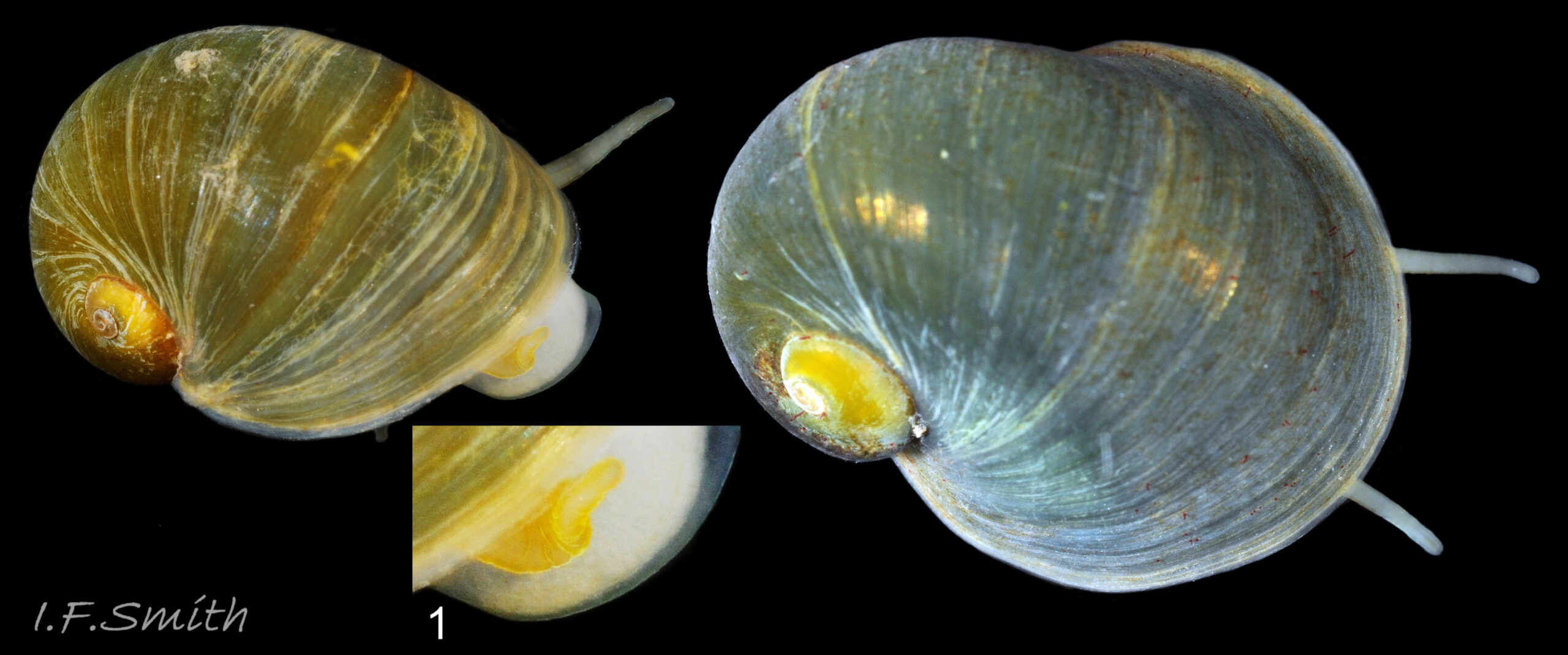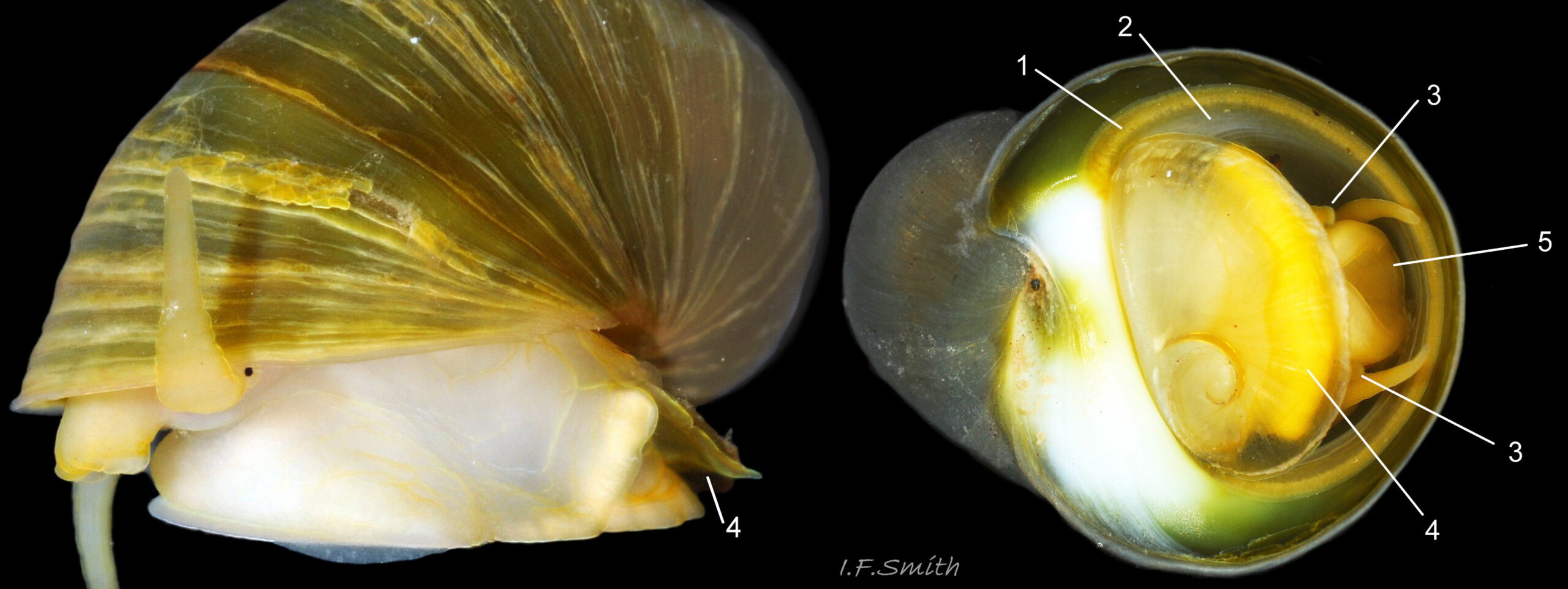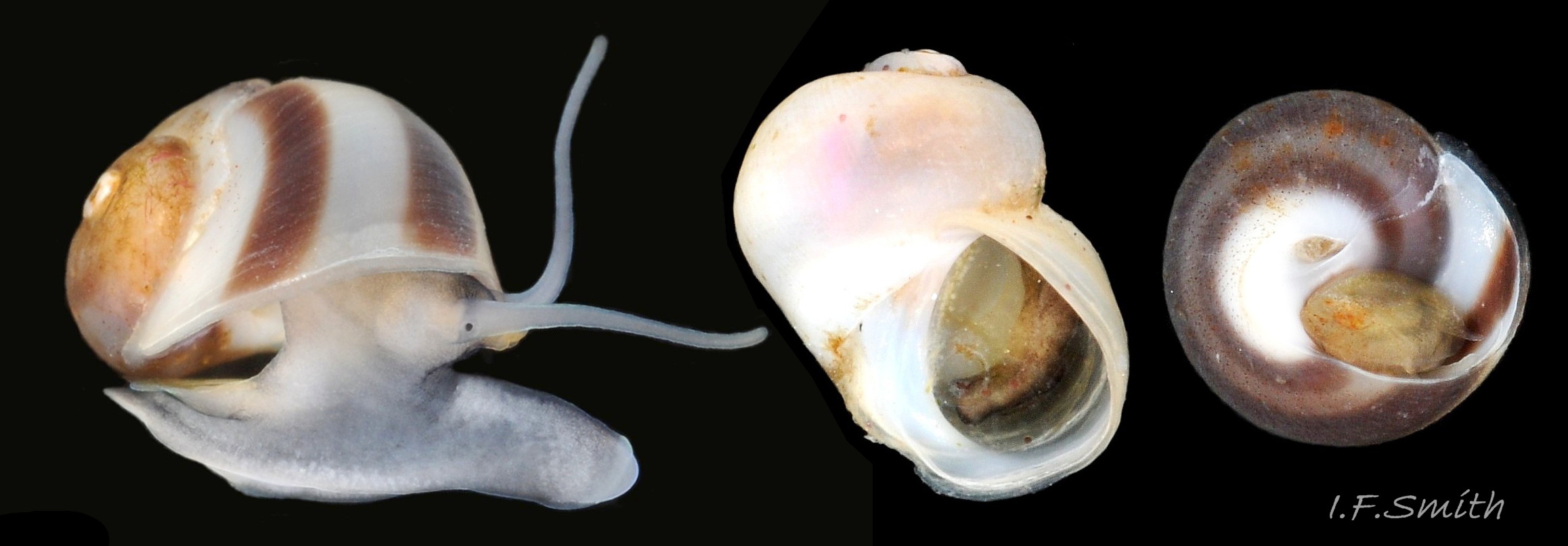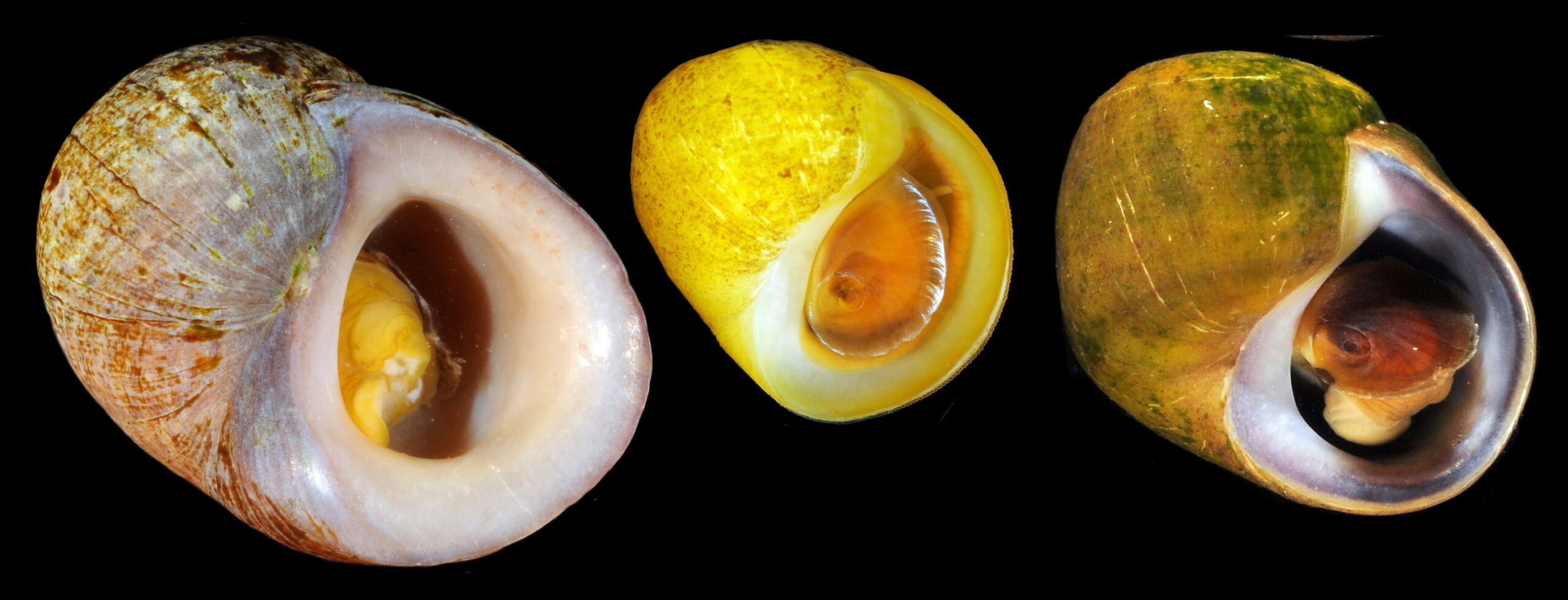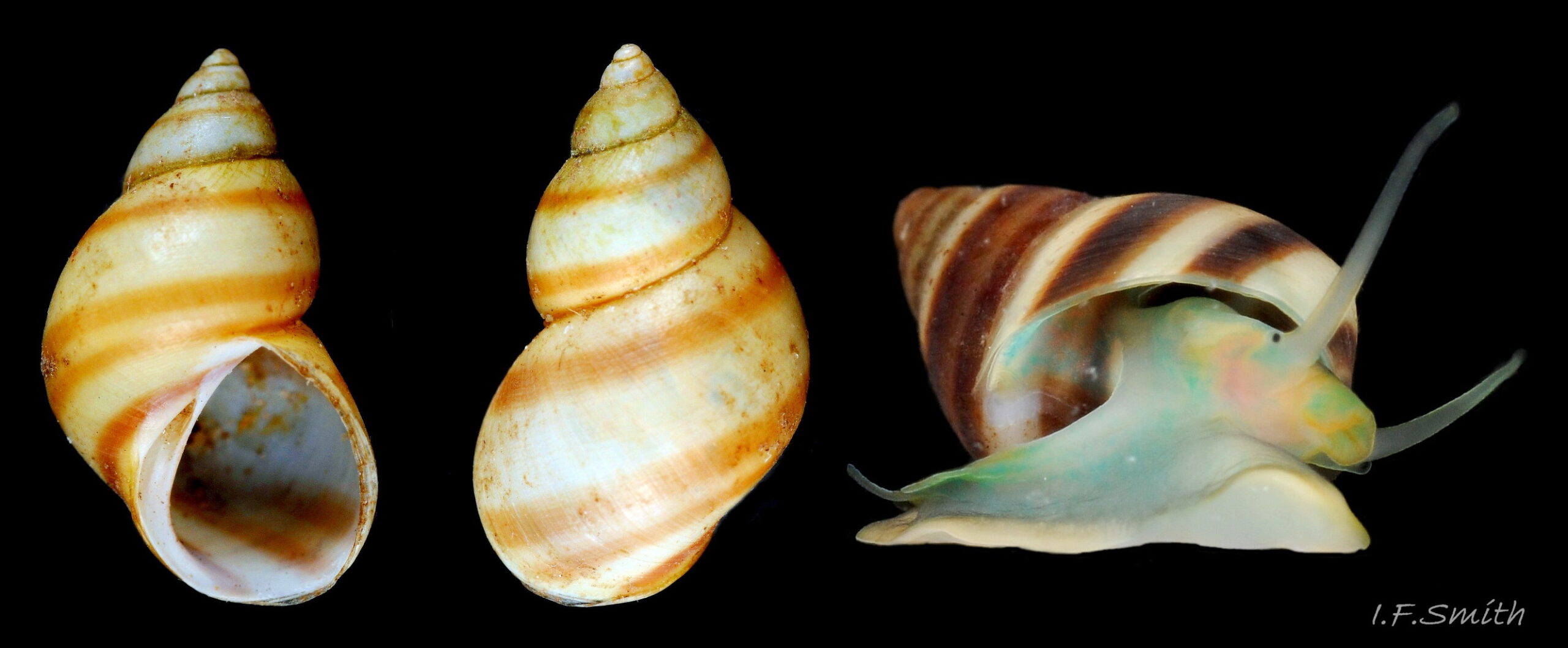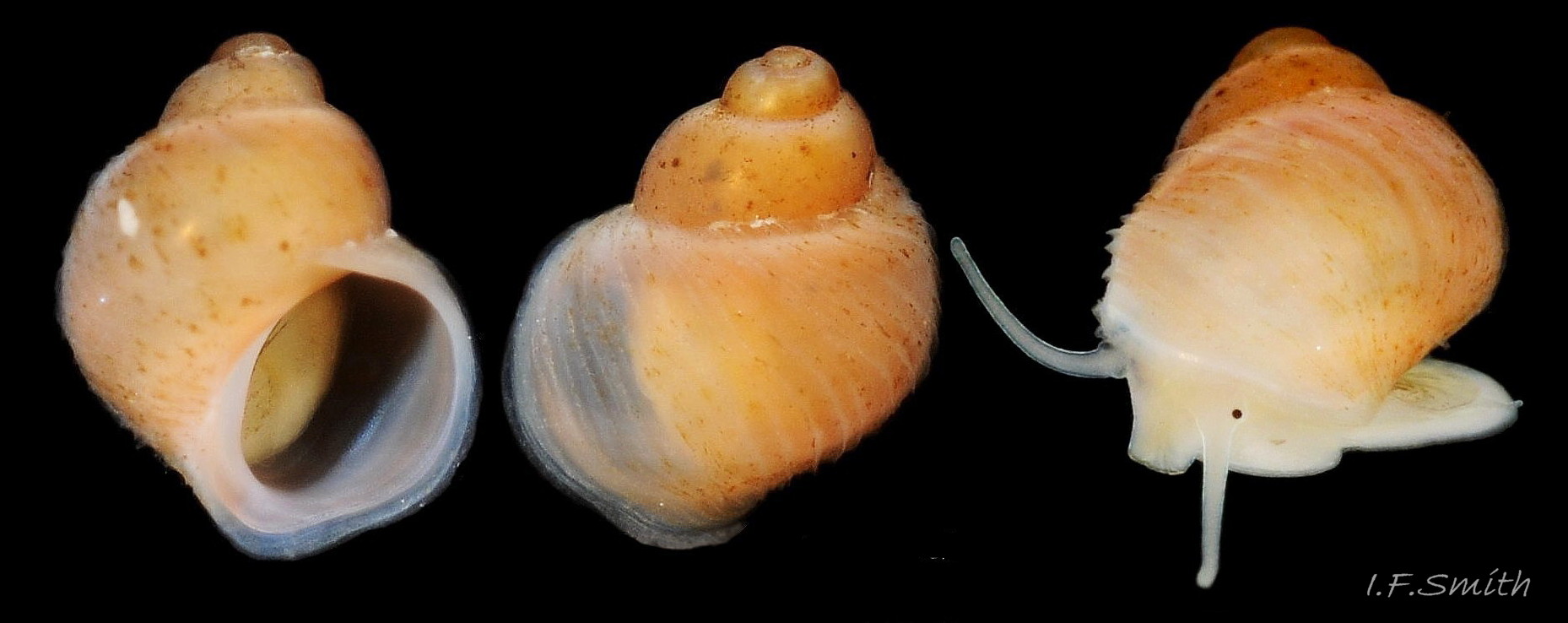Click image to enlarge with full caption. Main text below slider.
Lacuna pallidula (da Costa, 1778)
Revised PDF available at www.researchgate.net/publication/372768813_Lacuna_pallidu….
Synonyms:Cochlea pallidula da Costa, 1778; Lacuna neritoidea Gould, 1840; Lacuna patula Thorpe, 1844; Lacuna retusa Brown.
Current taxonomy: WoRMS www.marinespecies.org/aphia.php?p=taxdetails&id=140168
Vernacular: Pallid chink shell; Pale lacuna; Gwichiad agennog gwelw (Welsh); Lacuna pâle (French); Lavspiret grubesnegl (Danish); Bleke scheefhoren (Dutch); Blek lagunsnäcka (Swedish).
Shell description
The largest dimension of female shells is up to about 12 mm 01 Lacuna pallidula and males grow to 6 mm. The species has an annual life cycle; all or most adults are dead by June. Their small juvenile offspring occur in summer 02 Lacuna pallidula , growing to full size in winter. The body whorl forms the great majority of the shell, and the very small spire is sunk below the upper margin in most views. Juveniles are similar in form with a slightly lower spire. Sutures between the whorls are distinct. The smooth surface has no sculpture apart from numerous, growth lines.
One face of the hollow columella is missing, exposing a long wide columellar groove (lacuna, chink or canal), leading to a large funnel-like umbilicus 03 Lacuna pallidula . On some specimens the columellar groove is indistinct and the umbilicus reduced 04 Lacuna pallidula and 05 Lacuna pallidula .
The very large ‘D’ shape aperture is as high as the whole shell, and it occupies about 75% of the area in apertural-view images 01 Lacuna pallidula . The palatal lip is semi-circular, and it continues along the abapertural side of the columellar groove. The wide, white columellar lip forms the adapertural edge of the groove 03 Lacuna pallidula .
The ‘D’ shape operculum is a rapidly expanding oligogyrous spiral with its off-centre nucleus close to the base of the columellar lip. It is transparent, tinted yellow 04 Lacuna pallidula & 06 Lacuna pallidula or nearly colourless 05 Lacuna pallidula . The substantial periostracum is olive-brown with distinct growth lines on large specimens 07 Lacuna pallidula, and it usually extends beyond the lip of the aperture 04 Lacuna pallidula . Under the periostracum, the calcareous shell is white or yellowish white 01 Lacuna pallidula . Live adults with a thick opaque periostracum are olive-green/brown in water 08 Lacuna pallidula becoming dull brown when dead and dried 01 Lacuna pallidula . There are no coloured bands or variegation at any stage.
Body description
The flesh is translucent white with varying amounts of yellow or pink tinting 07 Lacuna pallidula and 05 Lacuna pallidula . The snout is ventrally slit fig.06 06 Lacuna pallidula and usually rolled into a cylinder 09 Lacuna pallidula . The extended cephalic tentacles are long, smooth, translucent whitish and taper to a blunt tip. When contracted they wrinkle and any yellow tint is intensified 08 Lacuna pallidula . There is a black eye on a slight bulge at the base of each tentacle 07 Lacuna pallidula . The roof of the mantle cavity is whitish translucent showing the colour of the shell except for the mantle edge which is thick and sometimes yellowish 09 Lacuna pallidula . The foot is white with varying amounts of yellow or pink 07 Lacuna pallidula , especially on the opercular disc which supports, and is visible under and through, the transparent operculum 05 Lacuna pallidula and 09 Lacuna pallidula . The two small, flat metapodial tentacles protrude beyond the posterior of the operculum 09 Lacuna pallidula .
Key identification features
Lacuna pallidula
1) Columellar groove (lacuna or chink) leads to umbilicus 01 Lacuna pallidula but is sometimes sealed over 04 Lacuna pallidula .
2) Largest dimensions up to 12 mm (female) and 6 mm (male). Hardly any of the spire protrudes beyond the body whorl 01 Lacuna pallidula
3) Very large ‘D’ shape aperture equals shell height and occupies about 75% of area in apertural view 01 Lacuna pallidula.
4) Shell olive-brown with no spiral bands 08 Lacuna pallidula .
5) Body white 07 Lacuna pallidula , sometimes yellowish or pinkish; no grey stipple.
6) Found mainly on Fucus serratus and sometimes on Laminaria.
Similar species
Lacuna parva (da Costa, 1778) 10 Lacuna pallidula COMPARE Lacuna parva. .
1) Columellar groove (“lacuna” or “chink) leads to umbilicus. 2) Usual maximum height 4 mm; sometimes 6 mm. Spire 30% to 40% of shell height.
3) Aperture occupies about 50% of area in apertural-view images.
4) Body whorl has three brown spiral bands; basal band 1 easily overlooked if base of shell not examined. Some shells are uniform white or brown with no bands.
5) Body translucent white, usually stippled grey.
6) Found mainly, especially when young, on small red weeds. Sometimes on fucoids.
Littorina fabalis (W. Turton, 1825) and
L. obtusata (Linnaeus, 1758) 11 Lacuna pallidula COMPARISON Littorina fabalis & L. obtusata .
1) No columellar groove or umbilicus.
2) Maximum dimension up to 17 mm. Very large body whorl and small spire.
3) Aperture occupies about 50% of area in apertural-view images.
4) Shell of L. obtusata is sometimes greenish olive.
5) Body varied shades of yellow, brown or black.
6) Found on Fucus serratus (L. fabalis) or Ascophyllum (L. obtusata) and on Fucus vesiculosus (both).
Lacuna vincta (Montagu, 1803) 12 Lacuna pallidula COMPARISON Lacuna vincta .
1) Columellar groove (“lacuna” or “chink”) leads to umbilicus. 2) Maximum height about 10 mm. Well developed spire about 50% of adult shell height, and about 30% on juveniles less than 3 mm high.
3) Aperture occupies about 30% of area in apertural-view images of full grown adults.
4) Body whorl has four brown spiral bands.
5) Body whitish with grey, yellow, orange and/or aquamarine parts.
6) Found on Laminaria and, especially juveniles, on small red weeds. Also on Zostera and sometimes on fucoids.
Lacuna crassior (Montagu, 1803) 13 Lacuna pallidula COMPARISON Lacuna crassior
1) Wide white columellar shelf. Usually no groove or umbilicus but sometimes small ones present.
2) Distinct spire about 50% of mature shell height, about 45% when younger.
3) Aperture occupies about 30% of area in apertural view.
4) Shell when live, has translucent, yellowish-brown spire and brownish-white body whorl. Thick periostracum has distinct, raised, transverse (costal) ridges. Dead dry shells are dull yellowish-brown if periostracum retained, yellowish white with faint spiral lines if periostracum worn off.
5) Body translucent whitish.
6) A rare species which often associates with the bryozoan Alcyonidium diaphanum.
Habits and ecology
L. pallidulafeeds on the surface of Fucus serratus (Smith, 1973) and Laminaria (Lebour, 1937) near low water on rocky shores and to 70 metres depth. It is usually absent where turbidity or soft substrate prevents growth of F. serratus. It cannot survive desiccation. Some populations live in the Baltic in salinity down to 12‰.
It moves with a bipedal stepping motion, lifting alternately the right and left sides of the foot. It breeds in late winter and spring, sometimes extending into summer and autumn, with a maximum in February to May in Britain, but precise dates vary regionally. The spawn mass is a low gelatinous dome with an almost circular, oval base (not kidney-shape), diameter 3.9 mm to 5.3 mm (Lebour, 1937), laid on fronds of F. serratus or Laminaria. There are up to about 200 ova per spawn mass 14 Lacuna pallidula . In the low salinity Øresund, Denmark, the masses are smaller with as few as 13 ova (Thorson, 1946 in Fretter & Graham, 1962).
Fretter and Graham (1962) reported confusion with the spawn of “Littorina littoralis” (the name mistakenly used formerly by British authors for an aggregate of Littorina obtusata and L. fabalis). The limited material examined for this account suggests the confusion is with L. fabalis which lives on F. serratus at the same shore level and lays similar, almost circular oval spawn masses, while L. obtusata lives higher up the shore, favouring Ascophyllum, and often lays kidney-shaped spawn masses up to 7 mm long. The difference between the spawn masses of L. fabalis and Lacuna pallidula may be that the latter has a distinctly bevelled peripheral rim while the surface of the former slopes to the substrate without a break in slope 14 Lacuna pallidula . But more investigation is required to test these suggestions; the difference might be due to age of spawn mass. Lacuna parva also has similar spawn but it is found on red algae and is smaller, about 2.5 mm diameter with about 50 ova in Britain 14 Lacuna pallidula ; 2.2 mm to 2.5 mm with 6 to16 ova in the brackish Øresund (Ockelmann & Nielsen, 1981 in Wigham & Graham, 2017).
The individual egg capsules of L. pallidula become angular as they swell and become crowded and compressed. There is no planktonic veliger stage; young emerge as tiny crawling snails. Through a microscope, just before hatching, two tentacular extensions of the opercular disc protruding beyond the operculum may be detected on the embryos within the clear capsules (Fretter & Graham, 1962). Males die after mating, and the females about a month later, so all or most adults breeding in the main period are dead by June or July, and few specimens over 5 mm high can be found in August 02 Lacuna pallidula . Both sexes grow rapidly until October. From October to February males grow slowly, but females at three times their rate so that by breeding time they are over twice as high as males (Thorson, 1946 in Fretter & Graham, 1962). When mating, the small male rides on the female’s shell near the aperture with his penis inserted into her mantle cavity.
Distribution and status
L. pallidula occurs from northern Norway and Iceland to Atlantic Spain and New England (USA). GBIF map www.gbif.org/species/2301181
It is found all around Britain and Ireland, but is scarce or absent in the north-eastern Irish Sea and southern North Sea where lack of hard substrate and/or turbidity hinder the growth of Fucus serratus and Laminaria. UK distribution map NBN species.nbnatlas.org/species/NBNSYS0000175975#tab_mapView
Acknowledgements
For use of an image, I thank Rob Durrant.
References and links
Forbes, E. & Hanley S. 1849-53. A history of the British mollusca and their shells. vol. 3 (1853), London, van Voorst. archive.org/details/historyofbritish03forbe/page/56/mode/2up
Also plate LXX11 at end of vol.4, fig. 1 & 2, also fig. 3 & 4 labelled “L. patula” archive.org/details/historyofbritish04forbe/page/n459/mod…
Fretter, V. and Graham, A. 1962. British prosobranch molluscs. London, Ray Society.
Graham, A. 1988. Molluscs: prosobranch and pyramidellid gastropods. Synopses of the British Fauna (New Series) no.2 (Second edition). Leiden, E.J.Brill/Dr. W. Backhuys. 662 pp.
Jeffreys, J.G. 1862-69. British conchology. vol. 3 (1865). London, van Voorst.
archive.org/details/britishconcholog03jeffr/page/350/mode…
Lebour, M.V. 1937. The eggs and larvae of the British prosobranchs with special reference to those living in the plankton. J. mar. biol. Ass. U.K., 22: 105 – 166. plymsea.ac.uk/953/
Ockelmann, K. W. and Nielsen, C. 1981. On the biology of the prosobranch Lacuna parva in the Øresund. Ophelia 20: 1-16.
Abstract at www.tandfonline.com/doi/abs/10.1080/00785236.1981.10426559
Smith, D. A. S. 1973. The population biology of Lacuna pallidula (da Costa) and Lacuna vincta (Montagu) in north-east England. J. mar. biol. Ass. U.K., 53: 493-520.
Thorson, G. 1946. Reproduction and larval development of the Danish marine bottom invertebrates. Meddelelser fra Kommissionen for Danmarks Fiskeri- og Havundersøgelser, Serie Plankton 4: 1-523.
Wigham, G.D. & Graham, A. 2017. Marine gastropods 2: Littorinimorpha and other, unassigned, Caenogastropoda. Synopses of the British Fauna (New Series) no.61. (344 pages). Field Studies Council, Telford, England.
Glossary
‰ = (salinity) parts salt per thousand parts water (brackish <30‰).
abapertural = away from the aperture.
abapical = away from the apex of the shell.
adapertural = towards the aperture
adapical = towards the apex of the shell.
aperture = mouth of gastropod shell; outlet for head and foot.
apical = at or near the apex.
chink = (see columellar groove).
columella = solid or hollow axis around which gastropod shell spirals; concealed except next to aperture where hollow ones may end in an umbilicus, slit or siphonal canal.
columellar = (adj.) of or near central axis of spiral gastropod,
columellar groove = Groove where one face of hollow columella missing, terminates in umbilicus. Also called “lacuna” or “chink.
columellar lip = lower (abapical) part of inner lip of aperture.
cephalic = (adj.) of the head.
costa = (pl. costae) rib crossing a whorl of a gastropod shell at about 90° to direction of coiling and any spiral ribs or lines.
costal = (adj.) of, or arranged like, costae.
ctenidium = comb-like molluscan gill; usually an axis with a row of filaments either side.
height = (of gastropod shells) distance from apex of spire to base of aperture.
lacuna = (see columellar groove).
mantle = sheet of tissue that secretes the shell and forms a cavity for the gill.
oligogyrous = (of a spiral) having few turns.
operculum = plate of horny conchiolin used to close shell aperture.
palatal lip = outer lip of gastropod aperture.
parietal lip = upper (adapical) part of inner lip of gastropod aperture that lies, often as a glaze, on surface of whorl.
periostracum = thin horny layer of conchiolin often coating shells.
plankton = animals and plants that drift in pelagic zone (main body of water).
protoconch = apical whorls produced during embryonic and larval stages of gastropod; often different in form from other whorls.
suture = groove or line where whorls adjoin.
umbilicus = cavity up axis of some gastropods, open as a hole or chink on base of shell, sometimes sealed over.
umbilical groove = narrow slit opening of umbilicus on some gastropods.
veliger = shelled larva of marine gastropod or bivalve mollusc which swims by beating cilia of a velum (bilobed flap).
